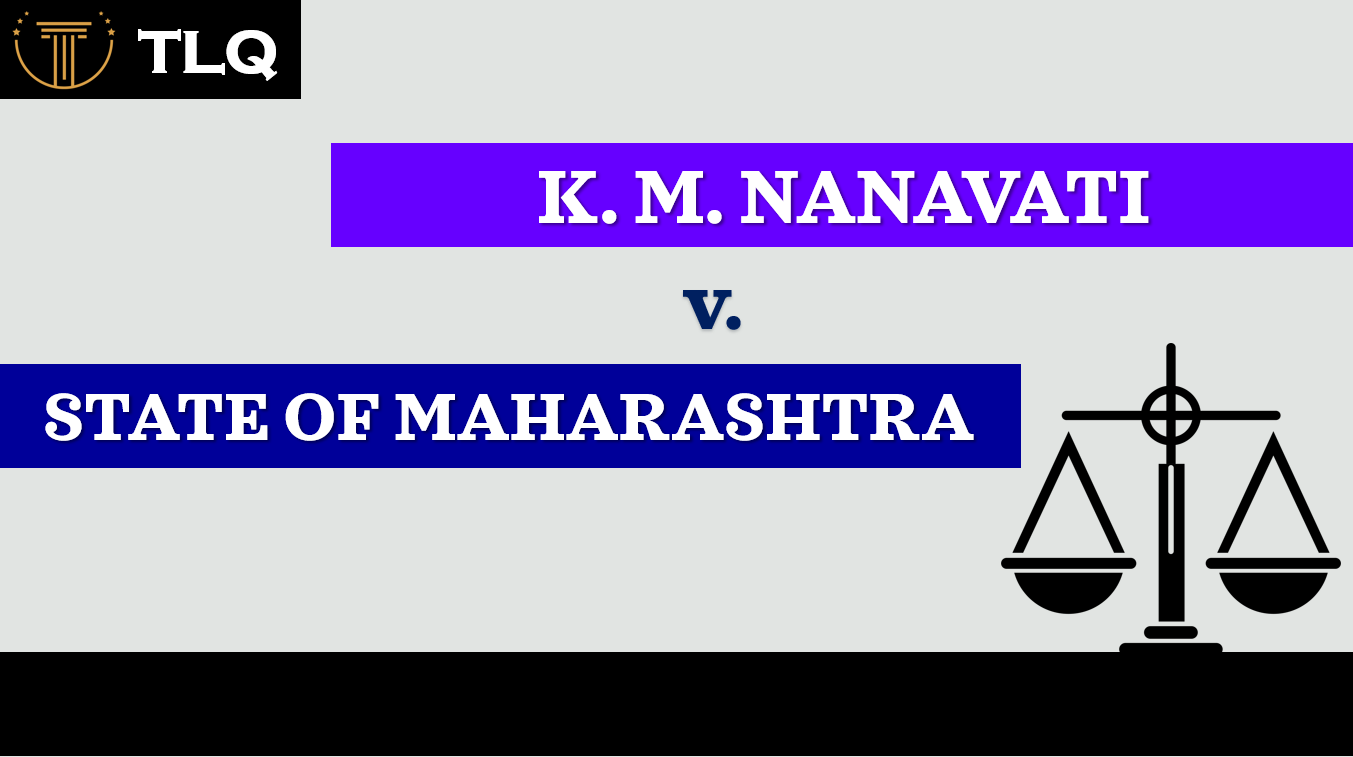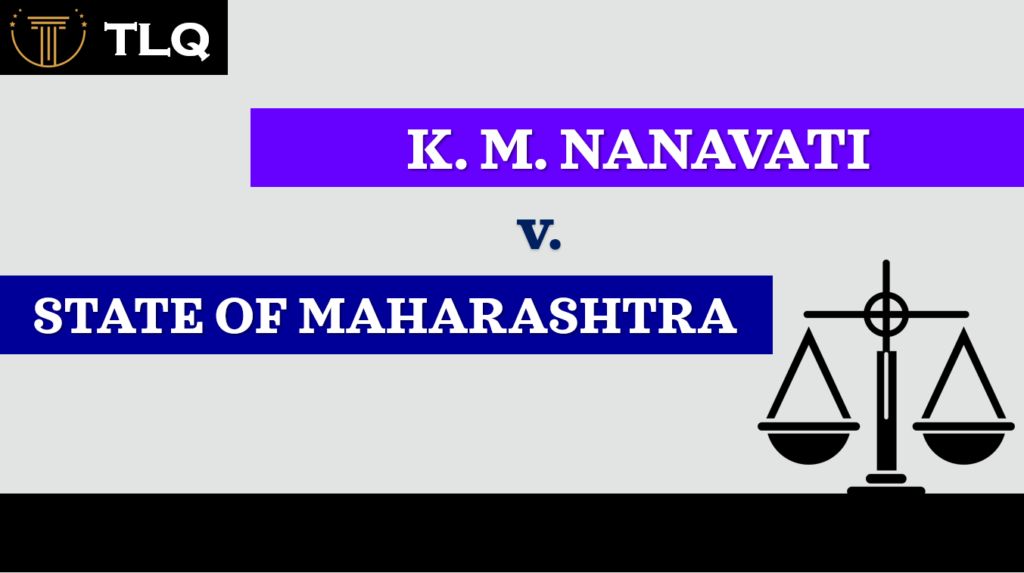Published On: 27th May, 2024

Authored By: Varisha Rehman
Asian Law College
AIR 1962 SC 605
FACTS
The accused was second in charge of the Indian Naval Ship “Mysore” at the time of the alleged murder. In 1949, he married Sylvia, who held England citizenship. Throughout their marriage, they had become parents to three children: a 9-year-old boy, a 5-year-old girl, and a 3-year-old boy. Owing to the nature of his work, Nanavati was forced to leave his wife and kids behind and move from Bombay to different locations. Prem Bhagwandas Ahuja and his sister Mimi Ahuja were introduced to Nanavati in Bombay through a consignment related to the purchase of a navy ship. He and his sister conducted business in automobiles. Ahuja was approximately 34 years old and unmarried when he passed away. As time passed on and Nanavati was living apart from Bombay, Sylvia and Prem Ahuja’s bond strengthened and they entered an illicit relationship.
When Nanavati got back to Bombay on a typical day, he made an effort to be close to his wife, against which Sylvia started to behave rudely. For a while, Nanavati ignored that. But when he realised that Sylvia was acting in a consistent manner on April 27, 1959, Nanavati questioned Sylvia about her behavioural changes for past few days. At first, she evaded the questioning but later, Sylvia admitted to Nanavati that she had an extramarital affair with Ahuja. Upon learning this, he fulfilled his promise to take his family to see the movie Tom Thumb at the Metro Cinema.
Furious with Ahuja’s actions, Nanavati proceeded to his ship and, using false justification, took six bullets and a semi-automatic revolver from the ship’s stocks and placed them in an envelope. He didn’t tell the authorities his precise plan which was to shoot himself, rather he told the authorities that he was going to drive alone to Ahmednagar at night and would need the weapon for safety.
Once his formal responsibilities were over, he loaded the pistol, went to Ahuja’s apartment, walked into his bedroom. When the deceased was discovered, the accused labelled him a filthy swine and inquired as to whether he was going to marry Sylvia and take care of the children. “Am I to marry every woman I sleep with?” shot back the deceased. They got into a fight, and in the midst of it, Ahuja was hit by two bullets, which killed him. The culprit then surrendered himself to police. After being placed under custody, he was eventually brought before the Sessions Court on a charge brought under section 302 of the Indian Penal Code.
In accordance with Section 302 of the Indian Penal Code, the jury delivered an 8-1 judgement, finding him not guilty. According to this section, “Whoever commits murder shall be punished with death or imprisonment for life, and shall also be liable to fine.” The jury gave him a majority of eight votes, with only one vote going against their verdict. But the jury’s decision did not satisfy the court.
ISSUES
- Whether it is possible for the High Court to overturn a jury’s verdict under Section 307(3) of the Cr.P.C. due to misdirection?
- Whether the charge contain any misdirection?
- Whether the verdict rendered by the jury one that a jury of reasonable men could have come to on the evidence that was given to them?
- Whether the murder was premeditated out or carried out in “the heat of the moment”?
- Whether it is possible to combine the Governor’s pardoning authority with the Special Leave Petition?
CONTENTIONS OF THE PLAINTIFF
Nanavati’s counsel stated that he contented Nanavati wanted to commit suicide after hearing Sylvia’s confession. But Sylvia was able to calm him down. He never had any intentions to kill Ahuja. He wished for his wife Sylvia to lead a happy life with the one she loved the most. After this, Nanavati was concerned as to Prem Ahuja’s genuine intentions and if he had plans to marry her and take custody of the children.
After leaving his spouse and kids at the movie theatre, he drove his car to the ship. He gave a false explanation for why he wanted the revolver—that he was travelling to Ahmednagar alone that evening and would need it for his protection—but in reality, he was intending to kill himself, not Ahuja.
He initially took his car to Ahuja’s office, but when he failed to find him, he took it to Ahuja’s flat and found a brown packet with a pistol inside and six bullets. As soon as Ahuja’s servant opened the door upon his arrival, Nanvati walked directly to Ahuja’s bedroom. He locked the door behind him and held the envelope containing a pistol and six rounds. Upon observing Ahuja in the bedroom, Nanavati called him a filthy swine and inquired if he would wed Sylvia and take care of the kids. “Am I supposed to marry every woman I sleep with?” said Ahuja furiously. This statement provoked Nanavati and threatened to beat Ahuja for the same. Prem Ahuja abruptly reached for the envelop, so Nanavati pulled out the gun and told him to step away. They then got into a fight, and it was during this struggle that Prem Ahuja died after being shot twice unintentionally.
Following that, Nanavati drove his car to the police station and surrendered himself in. As a result, Nanavati’s response was seen to be a severe and unexpected provocation because any kind and loving partner would become furious upon hearing a remark of that like and would attempt to harm the person who said it. Even if he committed the crime, it would only be considered culpable homicide and not murder.
CONTENTIONS OF THE RESPONDENT
First, respondent counsel raised questions about the appellant’s intentions by pointing out how the deceased had just returned from a shower and how it was possible for the towel to stay intact on his body during the scuffle. Nanavati calmly takes his wife, his children and a neighbour’s child to the movie theatre after Sylvia confesses to her.
Following this, he went to his ship and, under false pretences, obtained the revolver. This demonstrates clearly that he had enough time to calm down and that the provocation was neither severe nor sudden. While travelling, Nanavati intended to murder. If the grave and provocation came as unexpectedly, he would go straight to Ahuja’s flat and kill him using any weapon he had without first making a prearranged plan.
According to the statement of Ahuja’s servant Anjani, a natural witness, there were four shots fired rapidly after one another, and the whole incident took place in less than a minute. This could not have happened during a scuffle. After shooting Prem Ahuja, Nanavati departed the scene without telling his sister, who was in the next room. If Nanavati had told her it was an accident, she would have known. The Deputy Commissioner of Police stated that Nanavati was able to think rationally at the time since he acknowledged shooting Ahuja and even corrected his name, which was typed incorrectly in the police file. He was not in a daze and his mental condition was normal.
ISSUES
- EFFECTIVENESS OF JURY TRIALS – ISSUE 1, 2 and 3
The use of jury trials was one of the most noteworthy developments in this case. This was brought over from the judicial system of British. A jury trial involves a group of individuals, usually 12 in number, who are tasked with deciding whether or not the accused is guilty. The trial is conducted normally, including the presentation of arguments and evidence. But in this instance, the Indian jury trial’s advantages and disadvantages were both evident. To support the trial’s validity and impartiality, the members of the jury offered a diversity of viewpoints in this case.
However, on the other hand, the matter received a great deal of media coverage and public attention. The media was filming every move made by the parties and the members of the jury. The case received extensive notice in the media. This was thought to have an impact on the jury members. The complex nature of the case and its emotional content presented several difficulties for the jury in reaching a verdict.
The case was referred to the High Court for additional review by the sitting judge, Hon’ble Mr. Justice Ratilal Bhaichand Mehta, even though the majority vote of 8:1 was for acquittal. Section 307 of the Code of Criminal Procedure was used by the Session Judge to refer the case to the Bombay High Court’s Division Bench due to the dissatisfaction with the jury’s verdict. The case acted as an example for evaluating the effectiveness of India’s jury trial system.
- THE SUDDEN AND GRAVE PROVOCATION TEST – ISSUE 4
Section 300 of the Indian Penal Code has a few exceptions, one of which is sudden and grave provocation. In situations where one individual kills another person without warning or in the heat of the moment, they may be held accountable for culpable homicide that does not qualify as murder.
- SPECIAL LEAVE PETITION – ISSUE 5
The Supreme Court denied the Special Leave Petition in a majority ruling, ruling that the accused must surrender in accordance with Article 142 of the Constitution before the Special Leave Petition may be scheduled for a hearing.
HIGH COURT JUDGEMENT
Shelat and Naik, J.J., the division bench of the Bombay High Court, heard the matter. Even though the judges reached different conclusions in the case, they ultimately agreed that the accused was guilty of murder in accordance with Indian Penal Code Section 302. He ought to be imprisoned for life.
They came to the conclusion that the jury had been misled and the judges had found Nanvati guilty of murder after considering all the available evidence. In addition, he believed that the jury’s findings were irrational and twisted. They occasionally ran counter to the huge body of evidence.
On the other hand, Justice Naik believed that the jury’s judgement could not have been reached by any reasonable group of persons. The judges reached a consensus that there was insufficient evidence to lower the charge of murder to culpable homicide, which does not qualify as murder.
An appeal was made by the accused in the honorable Supreme Court.
SUPREME COURT JUDGEMENT
In light of all the facts and circumstances, the Court concluded that the accused had grown to the point of self-control and was thinking about his family’s future. He had plenty of time to collect himself and restore his emotional balance following Sylvia’s revelation. He had planned and deliberately calculated his actions. As a result, the act was viewed as premeditated murder and he was unable to use the defence of grave and sudden provocation.
The Court went into further detail regarding the relation between the Special Leave Petition (SLP) under Article 136 of the Indian Constitution, which gives the Supreme Court the discretionary power to allow special appeals to be made by any court or tribunal in India, and the Governor’s pardoning power under Article 161, which gives the Governor the ability to forgive or lessen the punishment of the convicted. The Court went on to make clear that these authorities cannot be utilised together; if one is used, the other becomes inoperative.
The Supreme Court of India denied the appeal and confirmed the High Court’s ruling. Nanavati was found guilty of murder in accordance with Section 302 of the Indian Penal Code after it was decided that the first exception to Section 300 of the code did not apply in this particular situation.
CONCLUSION
A significant turning point in the Indian judicial system’s history was the case of Nanavati, which ultimately resulted in the elimination of jury trials. In this case, distinctions between different forms of homicide and the jury’s restrictions were examined. The verdict offered valuable insights into the functioning of the Indian judicial system and the ways in which the media swayed the jury’s verdict.





